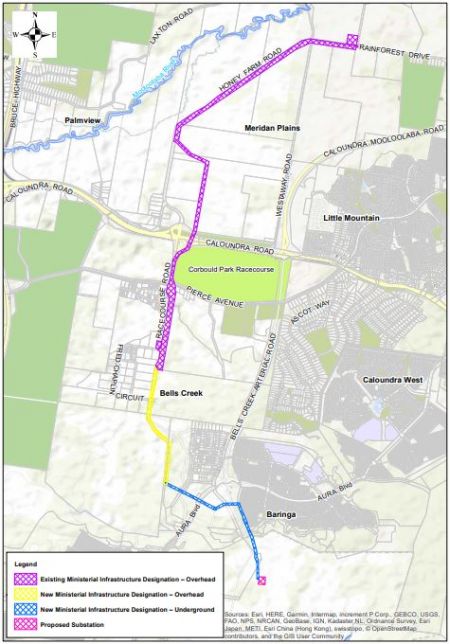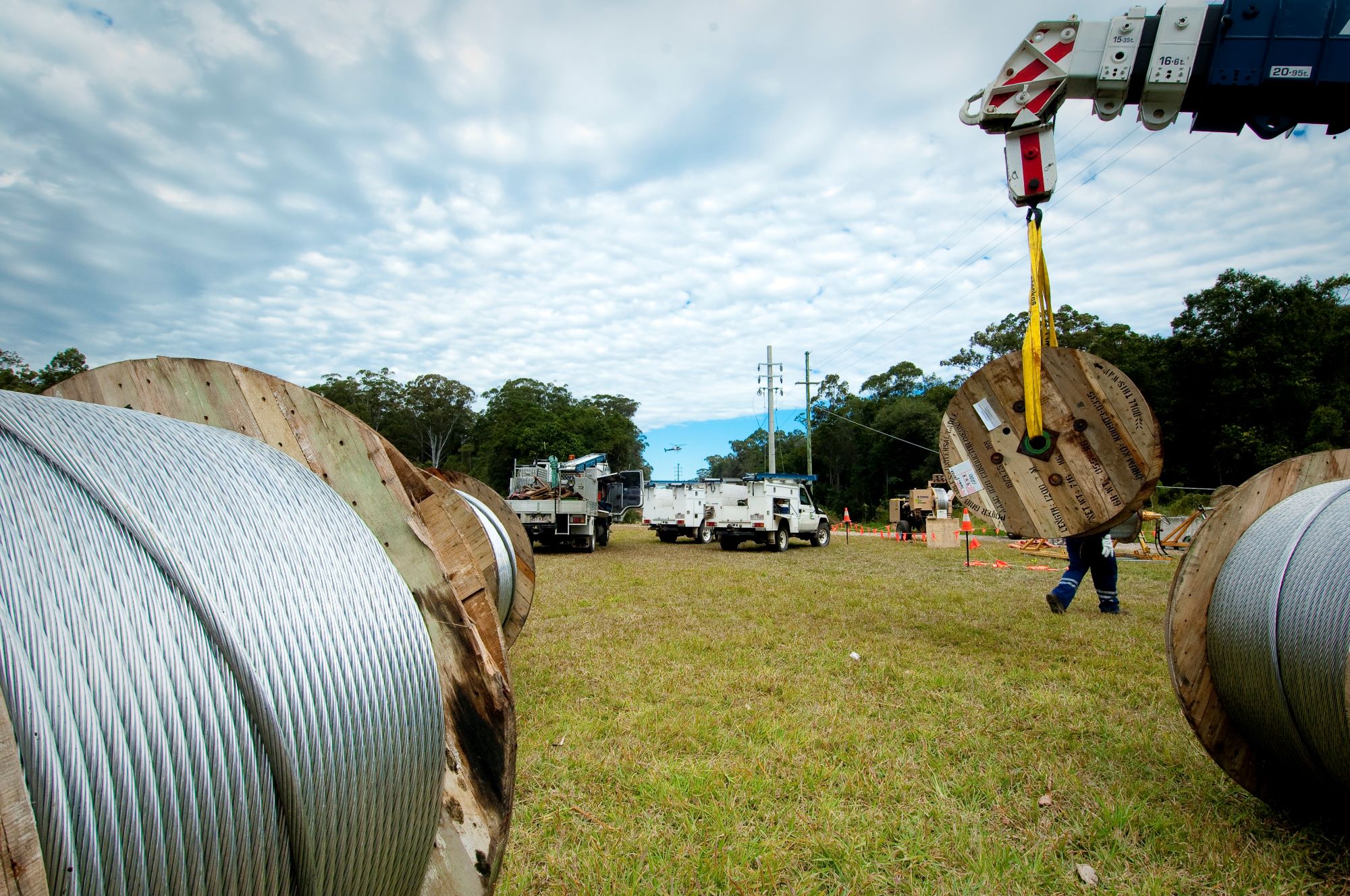SunSouth power project
We are investing in electricity infrastructure on the Southern Sunshine Coast to ensure power supply remains safe and reliable for decades to come.
The SunSouth Power Project will support the power supply to existing properties between Caloundra and Bells Creek. It will also ensure that we can cater for the additional 50,000 people expected to move to the new Aura residential community in the coming decades, as well as the commercial and industrial precincts, and educational and community facilities, planned for Caloundra South.
The power project consists of a 132kV dual circuit powerline that will stretch approximately 11 kilometres from Meridan Plains South into Baringa, and a new electricity substation that is being integrated into the Aura development.
The powerline and the substation project has been supported by a Ministerial Infrastructure Designations.
Construction of the powerline commenced in late 2024, with the foundations for the power poles currently being established. The standing of the poles and the stringing of the powerlines, as well as the underground powerline works, will start in mid-2025.
The civil and construction works for the substation is well progressed. Once complete, the electrical fit out of the control buildings will commence. The project’s final commissioning is targeted for mid-2026.
Keeping you informed
You can keep up to date and contact our team via the following information.
Newsletters
Download our newsletters to find out more.
Subscribe for updates
Use our Major Project Feedback Form and select ‘SunSouth Power Project’ in the 'Major project' drop down list. There is an option to provide feedback, or you can simply select that you would like to be sent future updates about this project at the bottom of the form.
Route map
Map showing the SunSouth power project route.
 Click/tap the image for a larger view of the map
Click/tap the image for a larger view of the map
Key project information
A number of factors have led to the requirement for the SunSouth project, including the:
- Expansion of the southern region of the Sunshine Coast
- Aura residential development and the Sunshine Coast Industrial Park
- General growth in energy demand on our network.
The new substation to be built as part of the Aura development, which is part of the new line, will also take demand off the Caloundra substation. This means that both substations will work together to deliver power to the southern Sunshine Coast and technicians will be able to transfer power between them, allowing for faster power restoration during unplanned outages caused by weather events such as storms.
The additional infrastructure will allow us to manage current and future electricity demand without risking security of power supply to the region.
The project includes an 11 kilometre powerline and a combination of overhead and underground 132kV dual circuit network, as follows:
- The proposed height of the poles along the overhead sections of the powerline currently range from 15 to 22 meters
- In the part of the route shown in yellow, currently under consultation for the new Ministerial Infrastructure Designation (MID), the poles planned will be 19 metres high on average
- The poles will either be concrete or steel
- The powerline will be placed underground in last two kilometres (shown in blue), along the back of the residential area.
A new substation will also be integrated into the Aura development (it will be known as Bells Creek Substation).
A Ministerial Infrastructure Designation, or MID, is a process for delivery of community-supporting infrastructure in a coordinated manner.
The MID process provides an alternative to lodging a development application with local government. It is managed by the Queensland Government. Under the Planning Act 2016, the Planning Minister is responsible for making decisions on MIDs.
The first section of the SunSouth Power Project already has an MID. It was gazetted in 2013. For the second section, we will be progressing through a process of making a new, additional MID. This process includes:
- Preliminary stakeholder engagement
- Lodgement process
- Another consultation process undertaken by both the Planning Minister and ourselves, to allow the community and other stakeholders to review and comment on the final proposed route.
Read more about Ministerial Infrastructure Designations.
Civil works are underway, and we are expecting to complete the project in 2027 (weather/disasters/unforeseen issues permitting).
We started planning for the project in 2013.
The main considerations in selecting a powerline route are:
- Minimising the potential impact on homes and businesses, recreation areas, scenic and tourism areas, conservation and heritage areas, or areas zoned for future development
- Avoiding extremely rough or steep terrain, including water bodies, where possible
- Minimising clearing of native vegetation and its potential habitat values and any impact on endangered and vulnerable ecosystems, or threatened flora and fauna species
- Minimising the impact on small land parcels and cultivated land.
Low levels of background noise are associated with normal substation operation, however, in the community the faint hum is generally indistinguishable from surrounding sounds.
As part of the environmental impact assessment for a substation site, a noise assessment is carried out in accordance with the Environmental Protection Act 1994, Environmental Protection Policy (Noise), and where necessary, noise reduction measures are put in place.
The cost to underground powerlines is significantly more than constructing them above ground, and they face different technical challenges in construction, with fault finding and repair, and safety during flooding, as well as the risk of accidental excavation damage.
Electricity infrastructure projects are a necessity and the solutions proposed must be considered cost effective. We aim to balance the costs, which are ultimately paid for by our customers, with any potential impacts from the infrastructure’s construction on the community.
When substations and powerlines are discussed, many people ask about electromagnetic fields (EMF). EMF are generated by any object with electric current flowing through it, including powerlines and all electrical appliances used in homes, such as televisions, washing machines, microwaves, hair dryers and computers.
The level of EMF from powerlines depends on the amount of current flowing along the lines. Fields decrease rapidly in strength the further you move away from the source.
Fortunately, EMF can be reduced by the configuration of substation infrastructure and powerlines. The project team will design the powerlines with this in mind. Our standards for EMF emissions continue to be better than those required by Australian and international health authorities.
Along the proposed line route and at the substation boundary, EMF levels are expected to be well within the limits required by the International Commission on Non-Ionising Radiation Protection (ICNIRP) and similar to those encountered in daily life. Tests will confirm this during a survey of the proposed powerline route and substation site before the project is completed.
Putting powerlines underground doesn't reduce the levels of EMF as the earth doesn't create a shield.
Our community engagement goal
We aim to provide the community with balanced and objective information to help in understanding the need for this project, our proposed solution and how it may affect people.
Our promise
We'll keep the local community informed, and we’ll acknowledge and consider any feedback.
We'll provide information in different ways including:
- Engaging personally with directly affected residents and landholders
- Distributing updates to the community
- Posting information on this website
- Providing additional information when requested.
Project contact details
For more information or to provide us with feedback, please contact the project team:
Online: Project feedback form

